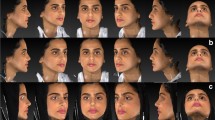Abstract
Purpose
Computer imaging has become increasingly popular for rhinoplasty. Three-dimensional (3D) analysis permits a more comprehensive view from multiple vantage points. However, the predictability and concordance between the simulated and actual result have not been morphometrically studied. The purpose of this study was to aesthetically and quantitatively compare the simulated to actual rhinoplasty result.
Methods
A retrospective review of 3D images (VECTRA, Canfield) for rhinoplasty patients was performed. Images (preop, simulated, and actual) were randomized. A blinded panel of physicians rated the images (1 = poor, 5 = excellent). The image series considered “best” was also recorded. A quantitative assessment of nasolabial angle and tip projection was compared. Paired and two-sample t tests were performed for statistical analysis (P < 0.05 as significant).
Results
Forty patients were included. 67.5% of preoperative images were rated as poor (mean = 1.7). The simulation received a mean score of 2.9 (good in 60% of cases). 82.5% of actual cases were rated good to excellent (mean 3.4) (P < 0.001). Overall, the panel significantly preferred the actual postoperative result in 77.5% of cases compared to the simulation in 22.5% of cases (P < 0.001). The actual nasal tip was more projected compared to the simulations for both males and females. There was no significant difference in nasal tip rotation between simulated and postoperative groups.
Conclusion
3D simulation is a powerful communication and planning tool in rhinoplasty. In this study, the actual result was deemed more aesthetic than the simulated image. Surgeon experience is important to translate the plan and achieve favorable postoperative results.
Level of Evidence IV
This journal requires that authors assign a level of evidence to each article. For a full description of these Evidence-Based Medicine ratings, please refer to the Table of Contents or the online Instructions to Authors www.springer.com/00266.



Similar content being viewed by others
References
Lekakis G, Claes P, Hamilton G, Hellings P (2016) Evolution of preoperative rhinoplasty consult by computer imaging. Facial Plast Surg 32:80–87
Singh P, Pearlman S (2017) Use of computer imaging in rhinoplasty: a survey of practices of facial plastic surgeons. Aesthetic Plast Surg. https://doi.org/10.1007/s00266-017-0858-3
Kiranantawat K, Nguyen A (2015) Asian rhinoplasty: pre-operative simulation and planning using Adobe Photoshop. Semin Plast Surg 29:232–246
Muhlbauer W, Holm C (2005) Computer imaging and surgical reality in aesthetic rhinoplasty. Plast Reconstr Surg 115:2104
Toriumi D, Dixon T (2011) Assessment of rhinoplasty techniques by overlay of before-and-after 3D images. Facial Plast Surg Clin N Am 19:711–723
Mehta U, Mazhar K, Frankel A (2010) Accuracy of preoperative computer imaging in rhinoplasty. Arch Facial Plast Surg 12:394–398
Adelson R, DeFatta R, Bassischis B (2008) Objective assessment of the accuracy of computer-simulated imaging in rhinoplasty. J Otolaryngol 29:151–155
Bronz G (1994) Predictability of teh computer imaging system in primary rhinoplasty. Aesthetic Plast Surg 18:175–181
Sharp H, Tingay R, Coman S, Mills V, Roberts D (2002) Computer imaging and patient satisfaction in rhinoplasty surgery. J Laryngol Otol 116:1009–1013
Sharp H, Rowe-Jones J (2003) Assessing outcome in aesthetic rhinoplasty. Clin Otolaryngol 28:430–435
Author information
Authors and Affiliations
Corresponding author
Ethics declarations
Conflict of interest
The authors have no financial or conflicts of interest to disclose.
Rights and permissions
About this article
Cite this article
Persing, S., Timberlake, A., Madari, S. et al. Three-Dimensional Imaging in Rhinoplasty: A Comparison of the Simulated versus Actual Result. Aesth Plast Surg 42, 1331–1335 (2018). https://doi.org/10.1007/s00266-018-1151-9
Received:
Accepted:
Published:
Issue Date:
DOI: https://doi.org/10.1007/s00266-018-1151-9




